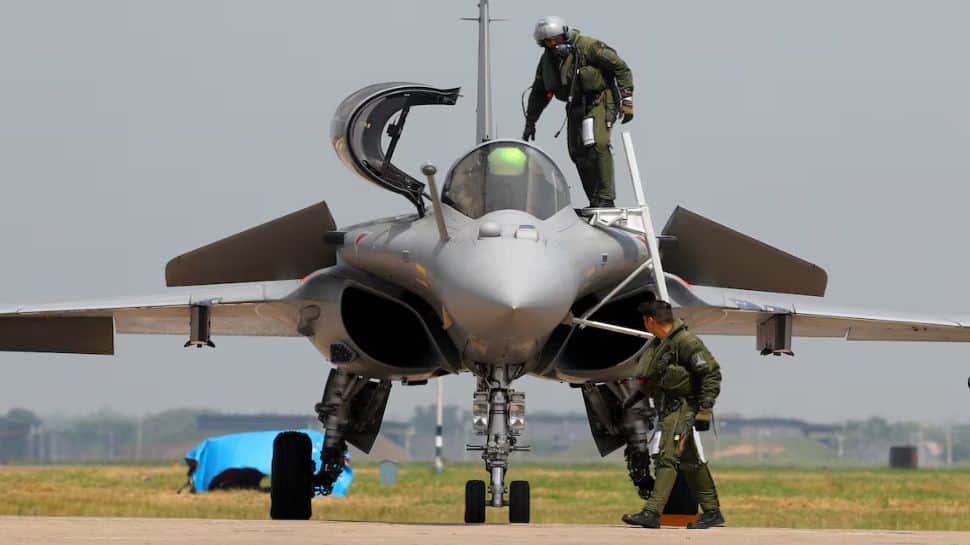Politics
India Shifts Focus to Indigenous Fighters, Rafale Deal in Doubt

India’s fighter jet ambitions are undergoing a significant transformation as the government pivots away from expanding its fleet of French-made Rafale aircraft. Instead, officials are increasingly prioritizing the development of indigenous fighter jets, aiming for self-reliance in advanced aviation technology. This strategic shift may lead to a slowdown in foreign purchases, even as the Indian Air Force (IAF) grapples with a pressing need for more aircraft.
The IAF is currently operating only 31 of the required 42 fighter squadrons, a gap that has been widening for years. Senior officers have continually advocated for additional Rafale jets, emphasizing that the French-built fighters offer unmatched combat readiness. Recently, the IAF submitted a proposal for 114 Rafale jets, but the government has requested more detailed plans, particularly regarding local manufacturing and technology transfer. The projected cost of this deal exceeds Rs 2 lakh crore.
Government’s Manufacturing Ambitions
Insiders indicate that the Indian government is keen for Dassault Aviation, the manufacturer of the Rafale, to produce key components within India. However, defense analysts warn that time is of the essence. If negotiations do not progress within the coming months, the viability of the Rafale deal may diminish. A retired IAF officer remarked to the defense website IDRW that the “window for the Rafale deal is closing fast.” With the indigenous Tejas Mk-2 and the advanced Advanced Medium Combat Aircraft (AMCA) gaining momentum, justifying further Rafale purchases could become increasingly challenging.
The Tejas Mk-2, a fourth-and-a-half-generation fighter jet, is steadily advancing, with its prototype expected to be ready by mid-2026 and the first flight slated for 2027. Full-scale production may commence by 2029 or 2030, featuring advanced avionics and an indigenous AESA radar. Meanwhile, the earlier version, Tejas Mk-1, is already in production, and the first batch will be delivered to the IAF soon.
Challenges and Alternatives
India has already acquired 36 Rafale jets for the Air Force and is in the process of procuring 29 more for the Navy. However, experts caution that any subsequent Rafale deal is likely to come with a hefty price tag and significant delays. Even if a contract were signed today, deliveries would not commence for at least three years. The government’s push for greater technology transfer and domestic manufacturing could prolong negotiations further.
Simultaneously, the Tejas Mk-2 is expected to enter serial production around the same timeframe. This overlap raises critical questions about whether India should invest billions in foreign jets when its own capabilities will soon be available.
In this complex landscape, Russia has emerged as a potential player, offering India its fifth-generation Su-57E fighter jet with a commitment to 100% technology transfer. This offer could enhance India’s strategic options, granting access to advanced Russian aviation systems while strengthening bilateral ties. Nevertheless, the Indian government remains cautious and appears to favor bolstering domestic capabilities over increasing foreign dependence.
With the focus shifting towards ramping up indigenous fighter jet production, the government has tasked Hindustan Aeronautics Limited (HAL) with increasing output and integrating more private sector involvement. HAL is working to expand its supply chain to Indian companies, aiming to create a comprehensive ecosystem for defense manufacturing. The long-term vision extends beyond aircraft production; it encompasses independence, job creation, and strategic fortification.
Defense analysts predict that with this policy shift, a third Rafale deal may never materialize. The government’s growing confidence in Indian technology signifies a pivotal moment in the nation’s defense strategy, as the spotlight now shines on the homegrown Tejas Mk-2 and AMCA.
-

 World5 months ago
World5 months agoSBI Announces QIP Floor Price at ₹811.05 Per Share
-

 Lifestyle5 months ago
Lifestyle5 months agoCept Unveils ₹3.1 Crore Urban Mobility Plan for Sustainable Growth
-

 Science4 months ago
Science4 months agoNew Blood Group Discovered in South Indian Woman at Rotary Centre
-

 World5 months ago
World5 months agoTorrential Rains Cause Flash Flooding in New York and New Jersey
-

 Top Stories5 months ago
Top Stories5 months agoKonkani Cultural Organisation to Host Pearl Jubilee in Abu Dhabi
-

 Sports4 months ago
Sports4 months agoBroad Advocates for Bowling Change Ahead of Final Test Against India
-

 Science5 months ago
Science5 months agoNothing Headphone 1 Review: A Bold Contender in Audio Design
-

 Top Stories5 months ago
Top Stories5 months agoAir India Crash Investigation Highlights Boeing Fuel Switch Concerns
-

 Business5 months ago
Business5 months agoIndian Stock Market Rebounds: Sensex and Nifty Rise After Four-Day Decline
-

 Sports4 months ago
Sports4 months agoCristian Totti Retires at 19: Pressure of Fame Takes Toll
-

 Politics5 months ago
Politics5 months agoAbandoned Doberman Finds New Home After Journey to Prague
-

 Top Stories5 months ago
Top Stories5 months agoPatna Bank Manager Abhishek Varun Found Dead in Well









